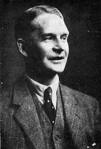Frederick Soddy
Frederick Soddy | |
|---|---|
 | |
| Born | September 2, 1877 |
| Died | September 22, 1956 |
| Residence | Brighton, United Kingdom |
| Nationality | British |
| Known for | Relativity |
Frederick Soddy was an English radiochemist, who received the [/wiki/Nobel_Prize_for_Chemistry Nobel Prize for Chemistry] in 1921.
In 1903, with Sir [/wiki/William_Ramsay William Ramsay] at [/wiki/University_College_London University College London], Soddy verified that the decay of [/wiki/Radium radium] produced alpha particles composed of positively charged nuclei of [/wiki/Helium helium]. In the experiment a sample of radium was enclosed in a thin walled glass envelope sited within an evacuated glass bulb. Alpha particles could pass through the thin glass wall but were contained within the surrounding glass envelope. After leaving the experiment running for a long period of time a spectral analysis of the contents of the former evacuated space revealed the presence of helium. This element had recently been discovered in the solar spectrum by Bunsen and Kirchoff.[#cite_note-0 [1]]
From 1904 to 1914, Soddy was a lecturer at the [/wiki/University_of_Glasgow University of Glasgow] and while there he showed that [/wiki/Uranium uranium] decays to [/wiki/Radium radium]. It was here also that he showed that a radioactive element may have more than one [/wiki/Atomic_mass atomic mass] though the chemical properties are identical. He named this concept [/wiki/Isotope isotope] meaning 'same place' - the word 'isotope' was initially suggested to him by [/wiki/Margaret_Todd_(doctor) Margaret Todd]. Later, [/wiki/J.J._Thomson J.J. Thomson] showed that non-radioactive elements can also have multiple isotopes. Soddy also showed that an atom moves lower in [/wiki/Atomic_number atomic number] by two places on alpha emission, higher by one place on beta emission. This was a fundamental step toward understanding the relationships among families of radioactive elements.
Soddy published The Interpretation of Radium (1909) and Atomic Transmutation (1953). In 1914 he was appointed to a chair at the [/wiki/University_of_Aberdeen University of Aberdeen], where he worked on research related to [/wiki/World_War_I World War I]. In 1919 he moved to Oxford University as Dr Lee's Professor of Chemistry, where, in the period up till 1936, he reorganized the laboratories and the syllabus in chemistry. He received the 1921 [/wiki/Nobel_Prize_in_chemistry Nobel Prize in chemistry] for his research in radioactive decay and particularly for his formulation of the theory of isotopes. - Wikipedia
Soddy was a critic of Einsteinian relativity, and organized what was probably the first conference dedicated to alternative approaches in 1954.